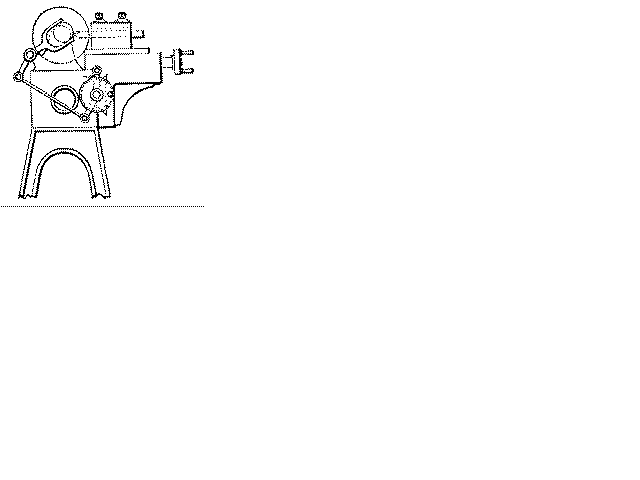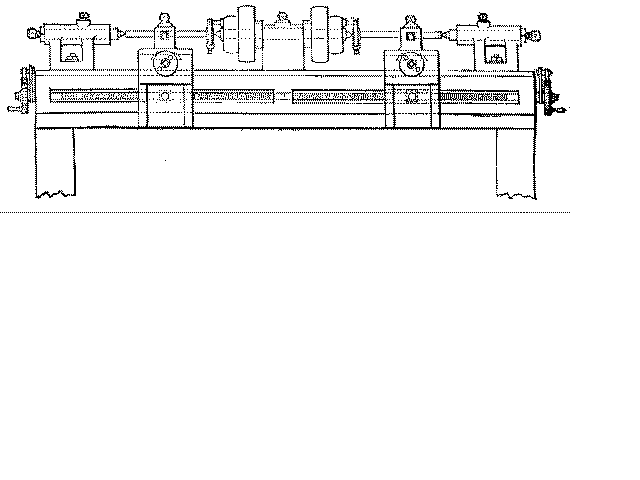case of some such material as cold malleable iron, it occurred to me to apply the tranquil but vast power of a hydraulic press to punch out a large hole in a thick cake of malleable iron. Knowing that my excellent friend John Rick had in his works at Bolton one of the most powerful hydraulic presses then existing, contrived and constructed by his ingenious father, the late Benjamin Hick, I proceeded to Bolton, and explained Dr. Faraday's requirement, when, with his usual liberal zeal, Mr. Hick at once placed the use of his great hydraulic press at my service.
Having had a suitable cake of steam-hammered malleable iron given to me for the purpose in question, by my valued friend Thomas Lever Rushton of the Bolton Ironworks, we soon had the cake of iron placed in the great press. It was 5 inches thick,18 inches long, and 15 inches wide. Placing a cylindrical coupling box of cast-iron on the table of the press, and then placing the thick cake of iron on it, and a short cylindrical mass of iron (somewhat of the size and form of a Stilton Cheese) on the iron cake, the coupling box acting as the Bolster of the extemporised punching machine, -- the press was then set to work. We soon saw the Stilton Cheese-like punch begin to sink slowly and quietly through the 5-inch thick cake of iron, as if it had been stiff clay. The only sound heard was when the punched-out mass dropped into the recess of the coupling below. Such a demonstration of tranquil but almost resistless power of a hydraulic press had never, so far as we were aware, been seen before. The punched of iron, together with the punched-out disc, were then packed off to Faraday; and great was his delight in having his request so promptly complied with. Great also was the wonder of his audience when the punched plate was placed upon the lecture table. This feat of Benjamin Hick's great hydraulic press set me a-thinking. I conceived the idea that the application of hydraulic press power might serve many similar purposes in dealing with ultra thick plates or bar iron, -- such as the punching out of holes, and cutting thick bars and plates into definite shapes, as might be required. I suggested the subject to my friend Charles Fox, head of the firm of Fox, Henderson, and Co. He had taken a large contract for a chain bridge, the links of which were to be of thick flat iron bars, with the ends broadened out for the link-pins to pass through. He had described to me the trouble and cost they had occasioned him in drilling the holes, and in cropping the rude-shaped ends of the bars into the required form. I advised him to try the use of the hydraulic press as a punching-machine, and also as a cutting-machine to dress the ends of the great links. He did so in due time, and found the suggestion of great service and value to him in this, and in other cases of a similar kind. The saving of cost was very great, and the work was much more perfect than under the former system.
A Turn-table "Trunnion Vision" Reflecting Telescope.
This is so arranged that the observer can direct the Telescope and view an object in any part of the heavens without moving from his seat, which is attached to the turn-table. For explanations, see text, p. 337.
A Double or Ambidexter Self-acting Turning-Lathe, with "Dead Gutters," specially adapted for turning Bolts and suchlike detail Parts of Machinery.


- This is a very valuable tool. It requires only one attendant. It is especially useful as regards efficiency and economy. It will be sufficiently understood by mechanical engineers from the annexed drawings.
A Reversible Rolling Mill without Fly-wheel.
This Rolling Mill consists of two combined steam-engines, acting on cranks at right angles, the reversing of the rolls being effected by the link motion. The requisite rolling power is obtained by suitable wheel and pinion gear, so as to be entirely independent of the momentum of a fly-wheel, which is entirely dispensed with.
I did not patent the invention. As usual in such cases, I made no secret of it, but sent sketches explanatory of the arrangement to many professional friends interested in mechanical improvements. It was adopted by many, especially for rolling long and heavy bars and plates. It enabled the workmen to "see-saw" these
| Previous chapter/page | Back | Home | Email this | Search | Discuss | Bookmark | Next chapter/page |